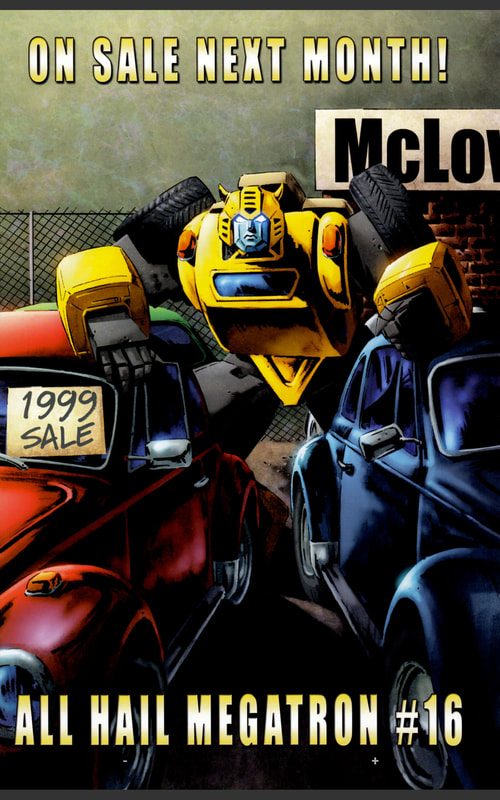If You Want to See Me do My Thing, Baby, Pull My String.
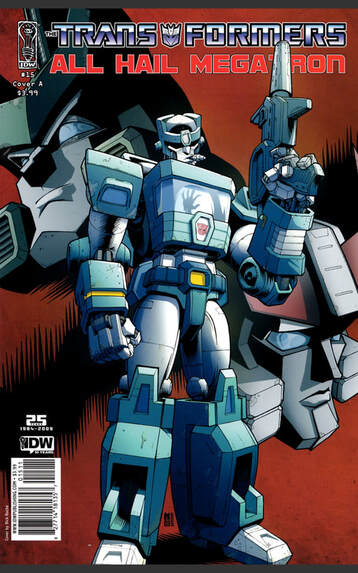
All Hail Megatron Issue 15: Everything in its Right Place/Lost and Found. September 16th 2009.
So now, when he speaks, you won’t even see my lips move.
You wait three issues for a good All Hail Megatron: Coda story to arrive, and then two come along at once. This is by far the best remembered, at least for the right reasons, issue of the add-on, largely for the first story, but there’s still an overall cohesion here that has been missing so far, and, SPOILERS, won’t make it to the end of the series.
It also gives us a notable first that’s hard to talk about at this point, the first credit for James Roberts, for “Assistance” on the writing of the Roche story. But, like how it was tough to discuss Furman’s final main continuity story with any pomp when it was a little afterthought, it’s hard to make a thing of the arrival of one of the keystone writers when his role here is officially just to have been a sounding board. And is likely to have been first and foremost Nick helping his mate finally get his foot in the door after a couple of years of trying to pitch stories.
That means, whilst there are ideas and concepts here that Roberts will take and run with, including a reference to 113, his equivalent of 47 in Star Trek, how much he actually contributed is hard to say and means that, for now, I’ll just acknowledge the moment and save talking about him more for his full forthcoming debut.
So now, when he speaks, you won’t even see my lips move.
You wait three issues for a good All Hail Megatron: Coda story to arrive, and then two come along at once. This is by far the best remembered, at least for the right reasons, issue of the add-on, largely for the first story, but there’s still an overall cohesion here that has been missing so far, and, SPOILERS, won’t make it to the end of the series.
It also gives us a notable first that’s hard to talk about at this point, the first credit for James Roberts, for “Assistance” on the writing of the Roche story. But, like how it was tough to discuss Furman’s final main continuity story with any pomp when it was a little afterthought, it’s hard to make a thing of the arrival of one of the keystone writers when his role here is officially just to have been a sounding board. And is likely to have been first and foremost Nick helping his mate finally get his foot in the door after a couple of years of trying to pitch stories.
That means, whilst there are ideas and concepts here that Roberts will take and run with, including a reference to 113, his equivalent of 47 in Star Trek, how much he actually contributed is hard to say and means that, for now, I’ll just acknowledge the moment and save talking about him more for his full forthcoming debut.
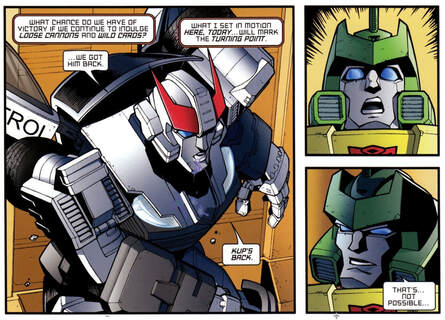 Battle of the jaws.
Battle of the jaws.
So, what does Everything in its Right Place give us to talk about? Well, if you flicked through it in the shop, the first thing you’d notice is that, after the opening splash page, this is a story of small panels full of dense text. A sharp contrast from what we’ve had recently, but it’s not because the plot is incredibly complicated, it’s because there is a real effort to dive deep into character and world building.
And also, course correction. Nick Roche wrote and drew a comic that left Kup in dire straits, which All Hail Megatron ignored right up till it threw a couple of mentions in right at the end, obviously something done after this new story had been commissioned. So here we have 11 pages that serve to square the circle, as well as set up some things for the forthcoming Wreckers series.
But is also does more than that, as we open on a punch, Springer knocking down Prowl with an uppercut as he demands to know where Kup and Perceptor are, like the rudest Smyths customer after Studio Series 86 toys.
All as Prowl, via his inner monologue, tells you the exact extent to which he’d predicted this behaviour, 98% certainty he’d be flat on his back once Springer went to visit Kup and found both him and his doctor missing.
Yes, this is the IDW story that defines Prowl. I’ve said over the years how I overall prefer the Marvel, and up to this point IDW, take of just a sensible guy frustrated with the idiocy going on around him. But the very cold, calculating manipulator playing three-dimensional chess is going to become the standard from now on.
And also, course correction. Nick Roche wrote and drew a comic that left Kup in dire straits, which All Hail Megatron ignored right up till it threw a couple of mentions in right at the end, obviously something done after this new story had been commissioned. So here we have 11 pages that serve to square the circle, as well as set up some things for the forthcoming Wreckers series.
But is also does more than that, as we open on a punch, Springer knocking down Prowl with an uppercut as he demands to know where Kup and Perceptor are, like the rudest Smyths customer after Studio Series 86 toys.
All as Prowl, via his inner monologue, tells you the exact extent to which he’d predicted this behaviour, 98% certainty he’d be flat on his back once Springer went to visit Kup and found both him and his doctor missing.
Yes, this is the IDW story that defines Prowl. I’ve said over the years how I overall prefer the Marvel, and up to this point IDW, take of just a sensible guy frustrated with the idiocy going on around him. But the very cold, calculating manipulator playing three-dimensional chess is going to become the standard from now on.
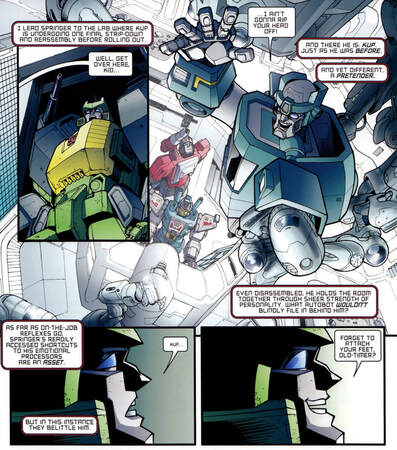 Find someone who looks at you like that.
Find someone who looks at you like that.
Except when it isn’t.
But, as much as I think some of the other writers will go overboard on it, there’s no denying that Nick Roche writes a bastard Prowl very well.
Because even as Prowl is reassuring Springer, all he can look at is the Wrecker’s dirty (including his own fuel dripping off them), never clean hands. And how the system is messed up that they rely so much on the Autobot’s last line of defence rather than making the first line better.
And after Springer quickly recaps the events of Spotlight: Kup (not just to re-establish the story, but also the art style), Prowl bullshits about a new, exciting technique having been developed on the Autobot weapons development base of Kimia, by Perceptor and Brainstorm working together in sympatico. Meaning in two panels, a location and two characters and their working relationship that will go on to both be important things to future comics are introduced in the most casual way.
Springer is initially worried all this is about learning to weaponize the radiation that affected Kup (something Prowl considered), but it’s all about the Pretender technology of Bludgeon’s, as recently perfected by Jetfire. Kup doesn’t have a shell (what a shame this comic has to work with the visuals of the previous issues set after this, full Pretender Kup would have been amazing), but his previously impossible to fix internal mechanics are now wired up the same way, leaving him as good as ever. Better.
Prowl leaves to his internal monologue that he’s had certain subroutines added during this process, and that Springer’s combination of guilt and hero worship is going to let him be played like a piano.
Though Springer still takes persuading, even after seeing an impressive video demonstration of Kup doing a training simulation, which even Prowl has to admit makes him almost see why people venerate Kup so much.
But, as much as I think some of the other writers will go overboard on it, there’s no denying that Nick Roche writes a bastard Prowl very well.
Because even as Prowl is reassuring Springer, all he can look at is the Wrecker’s dirty (including his own fuel dripping off them), never clean hands. And how the system is messed up that they rely so much on the Autobot’s last line of defence rather than making the first line better.
And after Springer quickly recaps the events of Spotlight: Kup (not just to re-establish the story, but also the art style), Prowl bullshits about a new, exciting technique having been developed on the Autobot weapons development base of Kimia, by Perceptor and Brainstorm working together in sympatico. Meaning in two panels, a location and two characters and their working relationship that will go on to both be important things to future comics are introduced in the most casual way.
Springer is initially worried all this is about learning to weaponize the radiation that affected Kup (something Prowl considered), but it’s all about the Pretender technology of Bludgeon’s, as recently perfected by Jetfire. Kup doesn’t have a shell (what a shame this comic has to work with the visuals of the previous issues set after this, full Pretender Kup would have been amazing), but his previously impossible to fix internal mechanics are now wired up the same way, leaving him as good as ever. Better.
Prowl leaves to his internal monologue that he’s had certain subroutines added during this process, and that Springer’s combination of guilt and hero worship is going to let him be played like a piano.
Though Springer still takes persuading, even after seeing an impressive video demonstration of Kup doing a training simulation, which even Prowl has to admit makes him almost see why people venerate Kup so much.
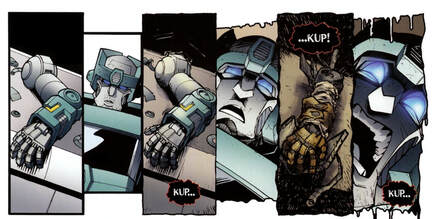 Outback comes back.
Outback comes back.
Springer however is concerned by the “Cy-Gar,” which like any smoking is bad for your health, but this is a special stogie of the radiation that Kup was addicted to, a means of weening him off it and preventing flashbacks. Prowl actually pushes the attempt to sound sincere a little too far for Springer, and has to backpedal, saying he may not like Kup too much, but he’s a role model everyone looks up to and that’s vital right now.
Indeed, something he’s counting on.
What persuades Springer though, is simply meeting Kup. Hanging from the ceiling and having his body put back together after an inspection, wisecracking, and bantering away, Springer immediately becomes putty, passing Prowl’s final test. And Springer’s sentiment and emotion is beautifully conveyed by the art, you can see the exact moment he decides to put all doubts aside and believe.
Which might be misplaced faith, as, in an outstanding moment of visual storytelling, Kup looks for his about to be reattached arm (jokingly calling it his “Fighting arm”), only for the art to shift to the style of Spotlight: Kup, and it’s suddenly his other fighting arm… that of Outback’s. And he can hear the voices chanting his name…
Till the Cy-Gar is back in his mouth and everything is back to normal. And what a shame that, we’ll never actually get a moment where this dependency becomes an issue with him becoming separated from it at a key moment.
Indeed, something he’s counting on.
What persuades Springer though, is simply meeting Kup. Hanging from the ceiling and having his body put back together after an inspection, wisecracking, and bantering away, Springer immediately becomes putty, passing Prowl’s final test. And Springer’s sentiment and emotion is beautifully conveyed by the art, you can see the exact moment he decides to put all doubts aside and believe.
Which might be misplaced faith, as, in an outstanding moment of visual storytelling, Kup looks for his about to be reattached arm (jokingly calling it his “Fighting arm”), only for the art to shift to the style of Spotlight: Kup, and it’s suddenly his other fighting arm… that of Outback’s. And he can hear the voices chanting his name…
Till the Cy-Gar is back in his mouth and everything is back to normal. And what a shame that, we’ll never actually get a moment where this dependency becomes an issue with him becoming separated from it at a key moment.
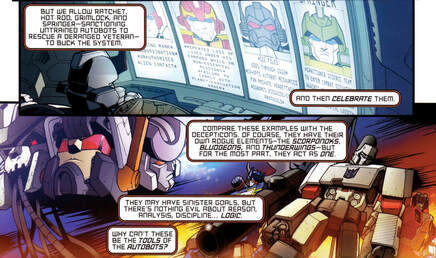 Prowl really likes to imagine Megatron at his sexiest.
Prowl really likes to imagine Megatron at his sexiest.
But despite that wobble, Springer is completely taken in, gushing about how much Kup means to them and how good it is to have him back. Something Prowl agrees with, Kup has never meant more to him either.
The next few pages show Roche’s skill at storytelling in a more subtle way. With the short length of the story, it has to cut between scenes that both have Prowl in on the same page. The addition of a coloured boarder around the scenes where he’s not with Springer is a simple one that the average reader wouldn’t even notice but compare it to the confused mess of a scene transition I talked about in Spotlight: Blaster, and it’s a simple trick that keeps the story flowing back and forth in a way that means you never get lost.
The one scene is basically a conversation with a reluctant Perceptor, who I’d forgotten is actually, however reticently, complicit in what has been done to Kup up to his neck. I think later, this would have been Brainstorm, and perhaps it’s a shame his own culpability will never be explored.
Still, his reticence gives Prowl an excuse to explain his thinking to us: The Autobots are too much in favour of impulsive, “Heroic” individualism. Characters like Grimlock, Ratchet and—in an especially bitchy touch that establishes how their future working relationship will be—Hot Rod go around breaking rules with impunity. Whilst the Decepticons, and this is quite the tell on Prowl’s part, may have some internal squabbles, but otherwise work better as a cohesive, sensible, unit. Which is an opinion completely divorced from anything we’ve seen in IDW to date, but I think that’s rather the point. He thinks he’s viewing things dispassionately, but he’s as myopic as anyone else.
And as even Optimus is swayed by impulsive voices and much more likely to listen to Ironhide than Prowl (complete with a flashback to Earth and the frustrated by the lack of action from the Decepticons Autobots, with Ironhide loudly suggesting action of some, any sort), it’s time for change to be bought in carefully.
The new subroutines in Kup will make him an advocate for a more considered approach, using his popularity and influence on everyone to change how the Autobots think, all whilst allowing Prowl to stay out of sight as he’s no desire for fame.
The next few pages show Roche’s skill at storytelling in a more subtle way. With the short length of the story, it has to cut between scenes that both have Prowl in on the same page. The addition of a coloured boarder around the scenes where he’s not with Springer is a simple one that the average reader wouldn’t even notice but compare it to the confused mess of a scene transition I talked about in Spotlight: Blaster, and it’s a simple trick that keeps the story flowing back and forth in a way that means you never get lost.
The one scene is basically a conversation with a reluctant Perceptor, who I’d forgotten is actually, however reticently, complicit in what has been done to Kup up to his neck. I think later, this would have been Brainstorm, and perhaps it’s a shame his own culpability will never be explored.
Still, his reticence gives Prowl an excuse to explain his thinking to us: The Autobots are too much in favour of impulsive, “Heroic” individualism. Characters like Grimlock, Ratchet and—in an especially bitchy touch that establishes how their future working relationship will be—Hot Rod go around breaking rules with impunity. Whilst the Decepticons, and this is quite the tell on Prowl’s part, may have some internal squabbles, but otherwise work better as a cohesive, sensible, unit. Which is an opinion completely divorced from anything we’ve seen in IDW to date, but I think that’s rather the point. He thinks he’s viewing things dispassionately, but he’s as myopic as anyone else.
And as even Optimus is swayed by impulsive voices and much more likely to listen to Ironhide than Prowl (complete with a flashback to Earth and the frustrated by the lack of action from the Decepticons Autobots, with Ironhide loudly suggesting action of some, any sort), it’s time for change to be bought in carefully.
The new subroutines in Kup will make him an advocate for a more considered approach, using his popularity and influence on everyone to change how the Autobots think, all whilst allowing Prowl to stay out of sight as he’s no desire for fame.
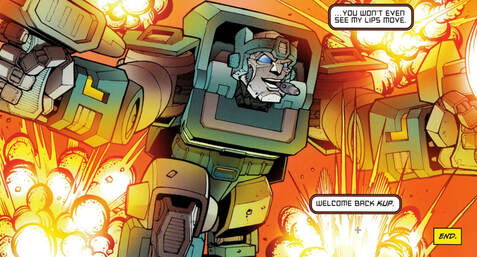 ...but not for long.
...but not for long.
Which doesn’t sound like a very sensible plan, but it’s hard to say how feasible it ever would have been when the outside factor of other writers doing different things with Kup means it never will get going. But in the 13 years since this issue came out, the idea of using the voices of influential people who can no longer speak for themselves to push an agenda has become even more pertinent. This week alone we’ve had Marilyn Monroe do a “new” fashion shoot, whilst recently Anthony Hopkins’ Twitter has been promoting NFTs in what has to be a case of elder abuse he has no control over. Or to go back a year or so, look how Captain Tom was used cynically by right wing Brits, including his own family.
This is a real, ongoing thing that is only going to get more so as digital manipulation gets easier, making this the most pertinent issue of Transformers IDW had yet done.
Springer, meanwhile, is absolutely adamant that Kup can never know about the Autobots he killed whilst under the influence, something that Prowl (after cheerfully putting a little dig in about those troops being sent to their death by Springer) is more than happy to agree to. So Kup, and Perceptor so as to keep an eye on Kup, and Springer are assigned to the same team and as Kup starts training again, Prowl is delighted that when the legend speaks…
…no one will see Prowl’s lips moving.
Well, look, I’ve written more on this one story than I did on the entirety of the last issue. We have here a writer and artist coming into the peak of his powers, producing great character work whilst exploring sophisticated ideas in a smart and thoughtful way, all whilst laying the foundations for stories that will play out over years.
And it’s not just dark and cynical. Roche is, at heart, an optimistic, hopeful writer. He just likes to make the road a difficult one to travel, and in opposition to Prowl’s cold manipulations, we have Springer’s faith and love for Kup. And even in isolation and ignoring what we know will come later, you always feel love will win in the end. Masterful.
This is a real, ongoing thing that is only going to get more so as digital manipulation gets easier, making this the most pertinent issue of Transformers IDW had yet done.
Springer, meanwhile, is absolutely adamant that Kup can never know about the Autobots he killed whilst under the influence, something that Prowl (after cheerfully putting a little dig in about those troops being sent to their death by Springer) is more than happy to agree to. So Kup, and Perceptor so as to keep an eye on Kup, and Springer are assigned to the same team and as Kup starts training again, Prowl is delighted that when the legend speaks…
…no one will see Prowl’s lips moving.
Well, look, I’ve written more on this one story than I did on the entirety of the last issue. We have here a writer and artist coming into the peak of his powers, producing great character work whilst exploring sophisticated ideas in a smart and thoughtful way, all whilst laying the foundations for stories that will play out over years.
And it’s not just dark and cynical. Roche is, at heart, an optimistic, hopeful writer. He just likes to make the road a difficult one to travel, and in opposition to Prowl’s cold manipulations, we have Springer’s faith and love for Kup. And even in isolation and ignoring what we know will come later, you always feel love will win in the end. Masterful.
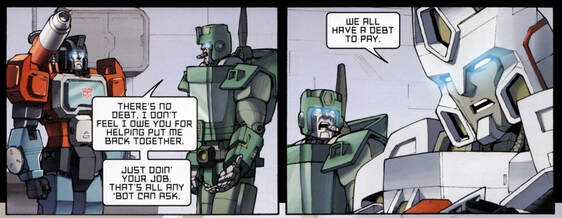 "He's my bitch now"
"He's my bitch now"
Now, imagine having to follow that up. It’s hard not to feel sorry for writer Denton Tipton and artist Casey Coller, if Lost and Found had been paired with any other story in this run, it would be the best thing in the issue. But, for all this means it gets overlooked as a result of the front end overpowering it, that this issue has connective issue between stories of Kup, Perceptor and recovering from serious personality affecting illnesses is more than welcome.
Following Spotlight: Drift, the severely injured Perceptor decides he owes Drift a debt, and intends to be more helpful as a solider, so he has made himself a tougher chest plate, replacement sharpshooter eye and a big honking gun.
Following Spotlight: Drift, the severely injured Perceptor decides he owes Drift a debt, and intends to be more helpful as a solider, so he has made himself a tougher chest plate, replacement sharpshooter eye and a big honking gun.
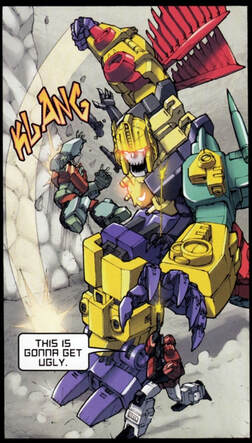 He's seen next issue.
He's seen next issue.
All of which disturbs an already worried by the loss of contact with other Autobots Kup (something Denton may even have intended to show his new towing the line personality), but a distress call from Hot Rod leaves them no time to discuss it. He’s been chased by Bludgeon and team Monstructor. There’s no attempt to explain how they’re out and about and working for the Decepticons again, but it is nice to see some of Furman’s more fun and well executed ideas return.
Kup takes everyone but Perceptor down to the planet that Hot Rod has crashed on, with them doing especially badly, till Perceptor arrives and uses his new gun to hit the crucial linking section on the combiner, breaking them up and forcing a retreat.
Now, that would have been useful against Devastator.
Kup thanks Perceptor, and decides they’re all going to go after the Decepticons, because they have a debt to pay…
Now, I’ve gone through that quickly in comparison to the first story, but basic competence is still very sexy after the last few issues, and this story manages to both get in and out quickly with a fast, nice little tale, but also has some decent character moments. Drift trying to teach Blurr Go (which, yes, is trying to push the “He’s Asian” side of the character hard, but also makes a change from chess as the game aliens get into) and being firm in his belief everyone has a debt to pay, Blaster of all characters being the one most disgusted by Perceptor defiling himself and, most importantly as it reaffirms the claims made about him in the opening, showing Kup as a competent caring leader.
Kup takes everyone but Perceptor down to the planet that Hot Rod has crashed on, with them doing especially badly, till Perceptor arrives and uses his new gun to hit the crucial linking section on the combiner, breaking them up and forcing a retreat.
Now, that would have been useful against Devastator.
Kup thanks Perceptor, and decides they’re all going to go after the Decepticons, because they have a debt to pay…
Now, I’ve gone through that quickly in comparison to the first story, but basic competence is still very sexy after the last few issues, and this story manages to both get in and out quickly with a fast, nice little tale, but also has some decent character moments. Drift trying to teach Blurr Go (which, yes, is trying to push the “He’s Asian” side of the character hard, but also makes a change from chess as the game aliens get into) and being firm in his belief everyone has a debt to pay, Blaster of all characters being the one most disgusted by Perceptor defiling himself and, most importantly as it reaffirms the claims made about him in the opening, showing Kup as a competent caring leader.
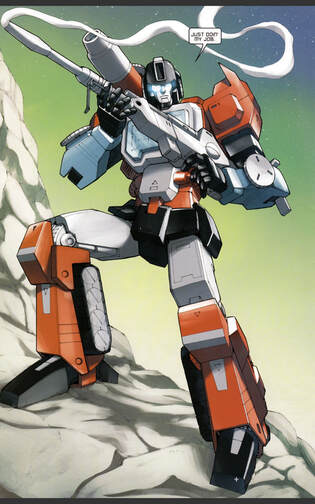 Never to be seen again: The Combiner Breaking Gun.
Never to be seen again: The Combiner Breaking Gun.
The only odd moment, and only so because of how McCarthy wrote the Cybertronians in this same series, is it turning out that they may have no concept of a clown, but they do know what a “Brainiac” is.
So, we end on facing the irony that the best issue of All Hail Megatron is one of the afterthoughts, and of all the teasing in the Coda issues for forthcoming series, the most successful has been for the miniseries that IDW themselves very much considered the third one out of the three that are coming with the relaunch.
This was frankly a much-needed oasis in the desert, one that must have left readers feeling much more confident about the future than they would have in months.
But will the final issue keep this newfound momentum going?
ALL HAIL MEGATRON ISSUE 14
2009
COMMENT
KO-FI
So, we end on facing the irony that the best issue of All Hail Megatron is one of the afterthoughts, and of all the teasing in the Coda issues for forthcoming series, the most successful has been for the miniseries that IDW themselves very much considered the third one out of the three that are coming with the relaunch.
This was frankly a much-needed oasis in the desert, one that must have left readers feeling much more confident about the future than they would have in months.
But will the final issue keep this newfound momentum going?
ALL HAIL MEGATRON ISSUE 14
2009
COMMENT
KO-FI



